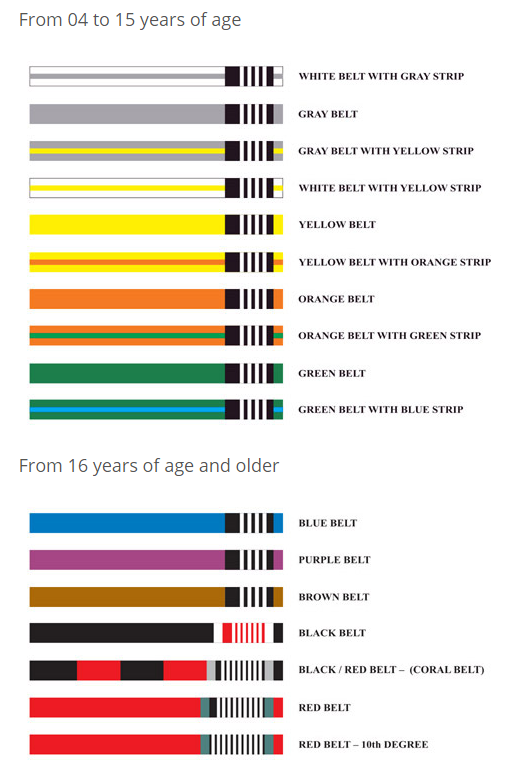
The Gracie Jiu -Jitsu Belt System
The belt and stripe system in Brazilian Jiu-jitsu is similar to all others. But there is a very big difference in how the belts are awarded
From an article on the subject in a Jiu-jitsu webzine:
History of the belt and stripe system
The use of belts was introduced into Judo by Kano Jigoro. At the time, he was only using white and black belts, white representing beginners, black representing advanced students. Mitsuyo Maeda, the student of Kano Jigoro, arrived in Brazil in 1914, a journey which would eventually lead to the development of Brazilian Jiu Jitsu. Additional colored belts are believed to have been added in 1935 by Mikonosuke Kawaishi in Judo, a system which would later be adopted by others as well. The first official belt ranking system in Jiu Jitsu was created in 1967 by the Jiu-Jitsu Federation of Guanabara, later to be implemented by the Sport Jiu Jitsu International Federation and International Brazilian Jiu Jitsu Federation.
There have been many discussions about what constitutes a certain level of competence in Jiu-jitsu. Some believe it is a designation of physical skill demonstration. Others believe it is more demonstrative of an ability to teach correctly. There are arguments supporting either view. And that is the important point.
What is common in both views is that it takes time studying, and mat time practicing, to get to whatever the next belt level is. In recent years they have added features to the belts to designate progress. For years , from time to time, after the professor acknowledges a certain level of progress in the student’s knowledge and capabilities he awards a stripe.. While it is traditional for a student to obtain four vertical white stripes on the black tip of the belt Stripes of different colors within the parent belt color have been added as benchmarks in the students development..
Belt colors and general meaning In all cases the question becomes is the student at this level becoming competitive with students at higher belts.
KIDS
White Belt – Everyone starts at this level in both kids and adults.
Yellow Belt – Exhibits familiarity with the basic moves and starts using techniques.
Orange Belt – Expands use of techniques and is more aggressive in applying pressure.
Green Belt – Shows command of the basics and is experimenting in expanding their game.
ADULTS
White Belt: Everyone starts at this level
Blue Belt: Must be at least 16. Begins to command the basics.
Purple Belt: Command of the basics and developing options on offense.
Brown Belt: Multidimensional game and teacher
Black Belt: a very high level of technical, tactical and mental understanding of the sport.
Beyond the Black Belt
Red / Black (Coral) Belt – When a Brazilian Jiu Jitsu black belt reaches seventh degree he is awarded an alternating red and black (also called Coral) belt. They are generally considered practitioners who have made a great impact into the world of Brazilian Jiu Jitsu and are often called “masters”.
Red / White Belt – Upon receiving the eighth degree, the practitioner will receive the red / white belt.
Red Belt – In the Gracie System the red belt is only reserved “for those whose influence and fame takes them to the pinnacle of the art”. It is awarded in lieu of a ninth and tenth degree black belt. Red Belts are often addressed by the title of “grandmaster”.
Criterias for ranking
It has to be said that each instructor has his own criterias for giving which means that your belt rank and stripes are subjective opinion of your instructor. You might be a purple belt at some gyms, you might be a blue belt at others. Each instructor has his own set of criteria by which they grade students so you have to take that into account. Some general criterias that are taken into account for giving stripes / promotions:
Skill level.
Attendance. In both consistency and attitude in the workouts, the student exhibits a will to learn.
Attitude. Being respectful, helping other students and generally having the right attitude will show that you embody the spirit of martial arts.
Time spent at current belt. There is a minimum time to be spent at all belts recommended by the IBJJF but the instructors can choose to give a belt earlier than that.
Visual recognition for senior students
The belt and stripes method also gives the instructor a way to visually mark the senior students in the class room thus letting junior students know who the skilled guys are and, potentially, who they can ask for assistance when the coach is unavailable.


